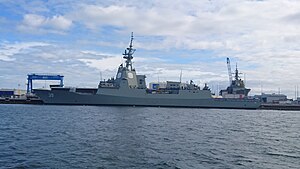Hobart-class destroyer

HMAS Hobart fitting out in June 2016
|
|
| Class overview | |
|---|---|
| Name: | Hobart class |
| Builders: |
|
| Operators: |
|
| Preceded by: | Perth-class destroyer and Adelaide-class frigate |
| Cost: | A$8 billion for 3 ships (original contract cost) |
| Built: | 2009–present |
| Building: | 3 |
| Planned: | 3 |
| Active: | 0 |
| General characteristics (as designed) | |
| Type: | Air warfare destroyer |
| Displacement: | 6,250 tonnes (6,150 long tons; 6,890 short tons) full load |
| Length: | 147.2 metres (483 ft) |
| Beam: | 18.6 metres (61 ft) maximum |
| Draught: | 5.17 metres (17.0 ft) |
| Propulsion: |
|
| Speed: | Over 28 knots (52 km/h; 32 mph) |
| Range: | Over 5,000 nautical miles (9,300 km; 5,800 mi) at 18 knots (33 km/h; 21 mph) |
| Complement: |
|
| Sensors and processing systems: |
|
| Electronic warfare & decoys: |
|
| Armament: |
|
| Aircraft carried: | 1 x MH-60R Seahawk |
The Hobart class is a ship class of three air warfare destroyers (AWDs) being built for the Royal Australian Navy (RAN). Planning for ships to replace the Adelaide-class frigates and restore the capability last exhibited by the Perth-class destroyers began by 2000, initially under acquisition project SEA 1400, which was redesignated SEA 4000. Although the designation "Air Warfare Destroyer" is used to describe ships dedicated to the defence of a naval force (plus assets ashore) from aircraft and missile attack, the planned Australian destroyers are expected to also operate in anti-surface, anti-submarine, and naval gunfire support roles.
Planning for the Australian Air Warfare Destroyer (as the class was known until 2006) continued through the mid-2000s, with the selection of the Aegis combat system as the intended combat system and ASC as the primary shipbuilder in 2005. In late 2005, the AWD Alliance was formed as a consortium of the Defence Materiel Organisation (DMO), ASC, and Raytheon. Between 2005 and 2007, Gibbs & Cox's Evolved Arleigh Burke-class destroyer concept and Navantia's Álvaro de Bazán-class frigate competed for selection as the AWD design. Although the Arleigh Burke design was larger and more capable, the Álvaro de Bazán design was selected in June 2007 as it was an existing design, and would be cheaper, quicker, and less risky to build.
...
Wikipedia
